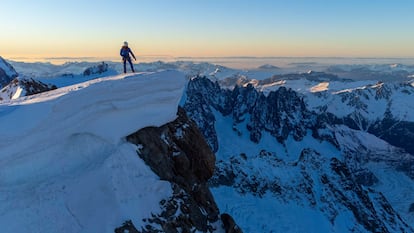How a French mountain guide managed first solo winter ascent of perilous Grandes Jorasses
Charles Dubouloz endured freezing temperatures and frostbite to join the ranks of the all-time greats by tackling the Rolling Stones route between France and Italy

Standing at the foot of the north face of Grandes Jorasses mountain (4,208 meters; 13,806 feet), one of the most striking summits in the world of mountain-climbing, nestled between France and Italy, Charles Dubouloz had a moment of doubt. Before him was an enormous wall of rock and ice stretching 1,200 meters (3,939 feet) from a sinister-looking glacier and fading into a blue sky, the fruit of an infinite anticyclone. Its legendary aura and history have broken the nerves of even the most fearless in the past. The French climber struggled against the icy wind as he weighed up the fear making him question whether he was about to take on too big of a challenge: a solo ascent in the middle of winter of the Rolling Stones route, one of the most demanding on the north face of the Grandes Jorasses. Finally, the 32-year-old took a deep breath, set his gaze forward and hoisted 35 kilos (77 pounds) of gear to the beginning of the route.
A solo ascent is not the same as free solo climbing. In the latter, a climber does not use ropes, harnesses or other protective equipment. One fall and it’s the end. But the few that practice this form of climbing are hooked to the freedom of moving without being weighed down, without pausing, fully enjoying the flow of their movements and the mental calm it brings. In the former, an alpinist climbs without the assistance of another person belaying. An enormous amount of work must be put in if the climber is to have much-needed security. Once they reach the end of their ropes, they must put in a new anchor for the ropes and descend to the bottom to collect their rucksack, remove the previous anchor and reset the fixed line. In other words, they have to scale up the wall twice.
Modern mountain climbing requires technique, great physical preparation and mental strength. Charles Dubouloz is one of the world’s leading climbers, a position he made clear last autumn by climbing the virgin northern face of Chamlang (7,319 meters; 24,012 feet) in Nepal in three days, alongside Benjamin Védrines. Now he has shown he is an all-star mountain climber in every respect – someone who is able to use all the techniques of mountaineering to face a huge challenge alone. Between January 13 and 18, the French mountain guide made history by becoming the first climber to complete a winter solo ascent of the north face of the Grandes Jorasses via the Rolling Stones route. This route was opened in 1979 by four Czech mountaineers (Tomas Prochazka, Jroslav Rutil, Ludek Schlechta and Jiri Svejda ), and was first completed in winter in 1984 by French climbing partners Benoît Grison and Éric Grammond.
Dubouloz spent five nights on the wall, lost between five and six kilos (11 to 13 pounds), endured temperatures of up to -30ºC (-22ºF), suffered frostbite in his fingers and ruined his hands, which were totally chapped from the cold, he said. But since achieving the historic feat, the applause from the alpinist community has not ceased. To make the ascent, Dubouloz had to climb over ice that was melting and giving way to broken rock, an experience that was very draining. He told the media that having to deal with bad rock – which could break under the weight of his feet– put him under a lot of stress. It is difficult to enjoy an ascent in these conditions. The need to reach safety pushed the climber to advance forward without losing sight of the goal, working all day and sleeping on a ledge or precarious hammock. Due to the tension, Duboulos ate hardly anything. His entire diet consisted of soup and hot water which he used to melt chewy sweets. He said he barely eats while on the mountain due to the stress.
It’s one of the ironies of alpinism: climbers spend years dreaming and wishing to be at the center of the action, but once they are there, they want to get back to safety. For this reason, there is no better prize than the warmth of the sun, a feeling of being bathed in life, which Dubouloz experienced when he reached the summit of Grandes Jorasses, after six days without feeling the sun. He took three steps and cried out: at last, he could relax and hug his friend, the photographer Seb Montaz, who had ascended the mountain on the Italian side and who, with the help of a drone, had documented Dubouloz’s feat.
In today’s world of stopwatches and immediacy, Dubouloz prefers to follow the lead of the mountaineer climbers of previous generations, when a slow pace and perseverance defined the epic ascents. Feats were not timed, simply because success was not a given. Before the French mountain guide, important names in alpinism such as Ivano Ghirardini (who soloed the Croz Spur route in winter in 1978 and was also the first person to make a solo ascent of the two other legendary north faces of the Grandes Jorasses: Cervino and Eiger), Juan Marc Boivin (1986), Marc Batard and Catherine Destivelle (1993), as well as Ueli Steck and Rémi Thivel, who all ascended the Rolling Stones route without knowing how the adventure would end. Dubouloz is the nexus between his idols of the past and the present, a mountain climber in sync with today’s world, one who understands that systematic training can take him very far, and in the process, improve upon what others have achieved before him.
Tu suscripción se está usando en otro dispositivo
¿Quieres añadir otro usuario a tu suscripción?
Si continúas leyendo en este dispositivo, no se podrá leer en el otro.
FlechaTu suscripción se está usando en otro dispositivo y solo puedes acceder a EL PAÍS desde un dispositivo a la vez.
Si quieres compartir tu cuenta, cambia tu suscripción a la modalidad Premium, así podrás añadir otro usuario. Cada uno accederá con su propia cuenta de email, lo que os permitirá personalizar vuestra experiencia en EL PAÍS.
¿Tienes una suscripción de empresa? Accede aquí para contratar más cuentas.
En el caso de no saber quién está usando tu cuenta, te recomendamos cambiar tu contraseña aquí.
Si decides continuar compartiendo tu cuenta, este mensaje se mostrará en tu dispositivo y en el de la otra persona que está usando tu cuenta de forma indefinida, afectando a tu experiencia de lectura. Puedes consultar aquí los términos y condiciones de la suscripción digital.
More information
Archived In
Últimas noticias
Most viewed
- Sinaloa Cartel war is taking its toll on Los Chapitos
- Oona Chaplin: ‘I told James Cameron that I was living in a treehouse and starting a permaculture project with a friend’
- Reinhard Genzel, Nobel laureate in physics: ‘One-minute videos will never give you the truth’
- Why the price of coffee has skyrocketed: from Brazilian plantations to specialty coffee houses
- Silver prices are going crazy: This is what’s fueling the rally










































